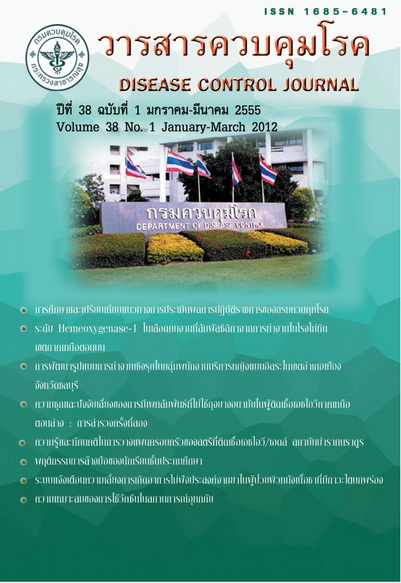Prevalence and Risk Factor of Unprotected Sex among HIV-infected Patients in Lower North: the Second Survey
Keywords:
HIV prevention, Disclosiue, Unprotected sexAbstract
Thai Ministry of Public Health had implemented the program for training health care provider to provider sexual health service for PLWHA. This study was the second survey of sexual behavior of PLWHA, one year after training. The survey was conducted in 40 hospitals in five provinces in lower north between July 2009 and October 2009. There were 1644 PLWHA, the mean age was 38 years. 50°/o knew their HIV status after being ill then getting HIV testing. 53°/o believed that they got HIV infection from spouse. The unprotected sex during previous three-months period was 22°/o which was higher than the first survey conducted one year before. Unprotected sex in the hospitals where staffs attended the training program was lower than in the hospitals where staff did not attend but not statistically significant (22°/o vs 24°/o). Factors which decrease reported unprotected sex were disclosure of HIV status to sexual partner, male sex, under antiretroviral treatment. Divorced, widow reported higher unprotected sex than single. Prevention among PLWHA needed not only the training program, but policy and programmatic support with continuous monitoring and evaluation were essential. Early treatment with antiretroviral treatment, HIV status disclosure to sexual partner counseling, coupe voluntary counseling and testing, condom promotion and provision might reduce HIV transmission among intimate sexual partners which now was the majority proportion of new HIV-infected person in Thailand.
Downloads
References
2. Brown, T., et al., Revising HIV Estimates and Projection Implications of The National Sexual Behavior Survey in The Era of ARV in the Generalized HIV Epidemic in Thailand: Research Approaches, A. Chamratrithirong and D. Phuengsamran, Editors. 2009, Institute for Population and Social Research Nakhon Pathom. p. 17.
3. National AIDS Prevention and Alleviation Committee, UNGASS Country Progress Report, Thailand. Reporting period: January 2006-December 2007, S. Petchsri, et al., Editors. 2008, Department of Disease Control: Bangkok, p. 16.
4. Crepaz, N. and G. Marks, Towards an understanding of sexual risk behavior in people living with HIV: a review of social, psychological, and medical findings. Aids. 2002; 16(2): 135-49.
5. Janssen, R.S., et al., The Serostatus Approach to Fighting the HIV Epidemic: prevention strategies for infected individuals. Am J Public Health, 2001. 91(7): p. 1019-1024.
6. อัจรา เชาวะวณิช, วีรวัฒน์ นโนสุทธิ, เยาวรัตน์ อินทอง และคณะ. พฤติกรรมเสี่ยงและการติดเชื้อ โรคติดต่อทางเพศสัมพันธ์ในผู้ติดเชื้อเอชไอวีใน สถาบันบำราศนราดูร. วารสารควบคุมโรค. 2550; 33: 42-59.
7. Centers for Disease Control and Prevention, Incorporating HIV prevention into the medical care of persons living with HIV. Recommendations of CDC, the Health Resources and Services Administration, the National Institutes of Health, and the HIV Medicine Association of the Infec¬tious Diseases Society of America. MMWR Recomm Rep., 2003. 52(RR-12): p. 1-24.
8. Chaiyamahapurk, S., S. Pannarunothai, T. Nopkesorn. Sexual Practice Among Thai HIV- Infected Patients: Prevalence and Risk Factors for Unprotected Sex. J Int Assoc Physicians AIDS Care. 2010; 9(5): 278-83.
9. UNAIDS, Getting to zero: 2011-2015 strategy Joint United Nations Programme on HIV/ AIDS (UNAIDS). 2010, Geneva: UNAIDS.
Downloads
Published
How to Cite
Issue
Section
License
Articles published in the Disease Control Journal are considered as academic work, research or analysis of the personal opinion of the authors, not the opinion of the Thailand Department of Disease Control or editorial team. The authors must be responsible for their articles.


.png)



